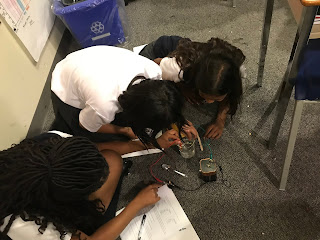Wonderful Wednesday!
We began the day with math. We first reviewed our understanding of mean, median, mode and range. Today we learned that data collection plays a very crucial role in the statistical analysis. In research, there are different methods used to gather information, all of which fall into two categories: primary data, and secondary data. Primary data is one which is collected for the first time by the researcher while secondary data is the data already collected or produced by others.
Primary data refers to the first hand data gathered by the researcher themselves.
Surveys, observations, experiments, questionnaire, personal interview, etc.
Secondary data means data collected by someone else earlier.
Government publications, websites, books, journal articles, internal records etc.
Primary data refers to the first hand data gathered by the researcher themselves.
Surveys, observations, experiments, questionnaire, personal interview, etc.
Secondary data means data collected by someone else earlier.
Government publications, websites, books, journal articles, internal records etc.
Other ways of collecting primary data: telephone, by canvassing door-to-door, or by observing situations.
We were asked, would we use primary or secondary data to find the favourite video game of Grade 6 students in Canada? We came to realize that we would use secondary data because we can’t survey all Grade 6 students in Canada.
Next, we dove into another crucial understanding when conducting surveys: biased and unbiased questions. We learned the importance of an unbiased question when conducting a survey and that a survey question must not lead a person to a particular answer. We were asked:
What is an example of a biased survey question? Candy is bad for your teeth. Should children eat candy? Why is this question biased? It includes a statement that may encourage people to answer no.
How can you rewrite the question so that it is unbiased? Should children eat candy? Yes ___ No ___ No opinion.
During this lesson we also addressed the importance of media literacy and being aware of the information that is being told to us. Biases are all around us. When a company is trying to sell their product, they are going to try and convince their audience to buy their product because this is their job. We learned that it is our job to recognize that biases exist and that we need to do our own research and come to our own opinions and conclusions.
We then practiced working with primary and secondary data and recognizing biased survey questions and rewriting biased questions in order to make them unbiased.
Next, we had French Mdm. Stella.
After first recess and lunch we watched an introduction to electricity video and practiced note-taking.
Then we had Music with Mr. Oliver.
When we returned we watched a video about atoms! It is important that we have a basic understanding of atoms so that we can understanding the flow of electricity.
We learned that everything is made up of atoms!! The tiny particles called atoms are the basic building blocks of all matter. Atoms can be combined with other atoms to form molecules, but they cannot be divided into smaller parts by ordinary means. The word atom comes from the Greek word atomos, meaning “indivisible.” The basic particles that make up an atom are electrons, protons, and neutrons.
We then used this knowledge to better understand how electrons flow through an electric circuit:
 We came to understand that electrons leave through the negative end of the battery and jump from atom to atom through the electric circuit in order to reach the positive end. Ms. Jaskolka made a silly joke to help us remember this: the electrons do not want to hang out with those who think negatively but instead they want to go hang out with their positive thinking friends!
We came to understand that electrons leave through the negative end of the battery and jump from atom to atom through the electric circuit in order to reach the positive end. Ms. Jaskolka made a silly joke to help us remember this: the electrons do not want to hang out with those who think negatively but instead they want to go hang out with their positive thinking friends! After second recess and lunch we explored conductors and insulters through an experiment. We tested various materials to find out which would act as a conductor (would allow electricity to flow and light up the bulb) or an insulator (would stop the flow of electricity and the bulb would not light up.) Check it out!!
At the end of the day we talked about our idiom from yesterday: a hot potato. Ms. Jaskolka is really impressed with the research the students did to find out the meaning of this idiom!! Students described a hot potato as a difficult situation to deal with or a sticky situation and that it means there is an argument where disagreements occur. We then started discussing some examples of a hot potato. The students mentioned politics, evolution and religion to name a few!
Our idiom for today: a penny for your thoughts. We will discuss this idiom tomorrow!
Homework:
1. Read Daily
2. Write about a day without electricity
3. Cursive 2 pages
4. Math sheet about biased and unbiased surveys
5. Bus form
6. Science fair form
7. French homework about accents



































No comments:
Post a Comment